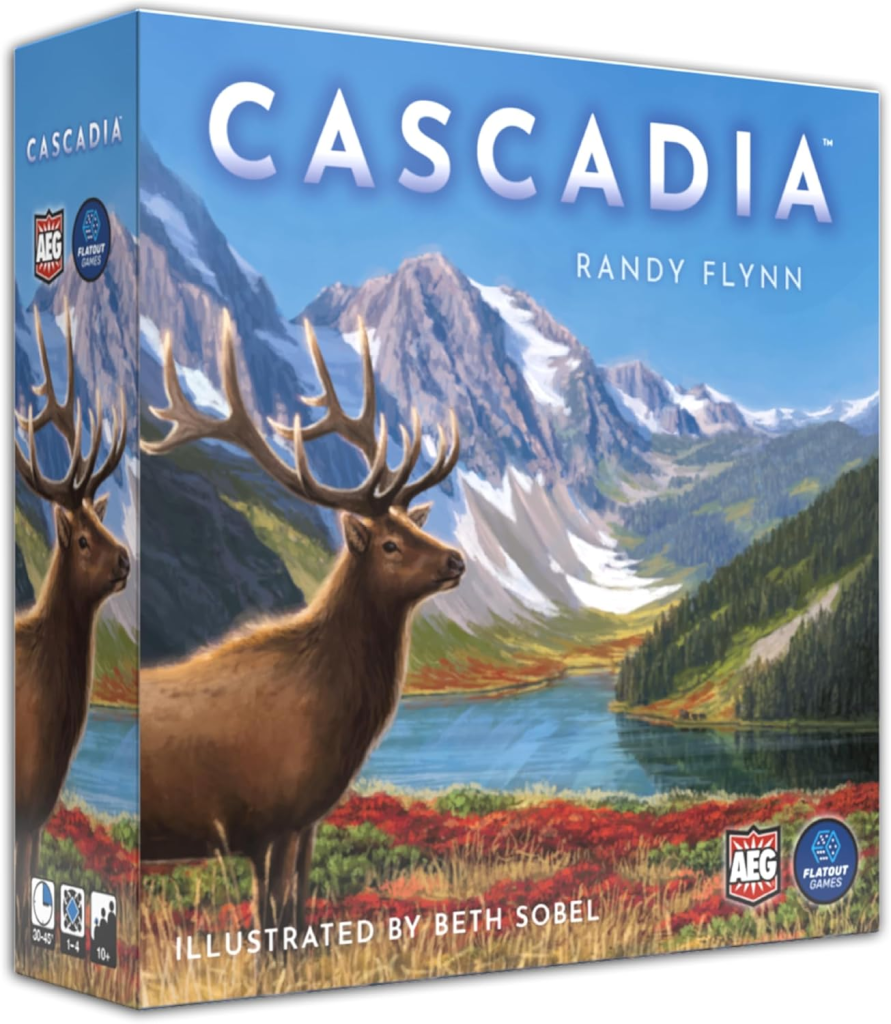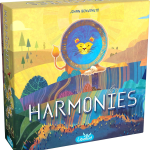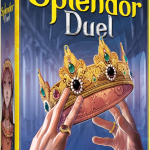When a nature-themed puzzle game wins the prestigious Spiel des Jahres award, captures top spots on BoardGameGeek’s rankings, and generates endless buzz in the gaming community, you know something special has landed on tables worldwide. Cascadia, designed by Randy Flynn and published by AEG and Flatout Games, accomplishes what few games manage: it makes sophisticated strategic gameplay feel effortlessly accessible while maintaining genuine depth that keeps experienced gamers coming back for more.
Despite all the competition sitting on shelves, players return to Cascadia repeatedly for a simple reason: the puzzle and gameplay is just so darn enjoyable. But does this Pacific Northwest nature builder live up to its substantial reputation? Let’s explore what makes Cascadia one of the most beloved board games of recent years.
What Is Cascadia?
Cascadia is a tile-laying and token-drafting puzzle game for 1-4 players set in the Pacific Northwest region encompassing Oregon, Washington, Idaho, British Columbia, and the Yukon Territory. Your aim is to make large realms of matching habitats and to fulfill the scoring objectives on the set of animal cards you chose during setup. You get points per tile of each habitat in your biggest region of that type, and bonus points are on offer if you have the largest area of each habitat amongst all players.
Over 30-45 minutes, players draft hexagonal habitat tiles and wooden animal tokens, placing them strategically to create the most harmonious ecosystem and score the most points. The gameplay combines elements of pattern recognition, spatial puzzling, and set collection into a remarkably elegant package.
Setup: Quick and Intuitive
First, remove habitat tiles according to the setup in the rulebook depending on player count. Choose a set of Wildlife Scoring Cards and lay them out for all to see. Then, give each player a random starting board and decide on the first player. Place stacks of the remaining habitat tiles face down, the bag of wildlife tokens and nature tokens within easy reach. Finally, reveal four habitat tiles face up and four nature tokens to create the market.
The entire setup process takes approximately two minutes, making Cascadia ideal for spontaneous game sessions or as a warm-up before heavier games.
Gameplay: Elegant Simplicity with Strategic Depth
The Core Turn Structure
There is only one rule: From a selection of landscapes and animals, you choose exactly one pair of landscape and animal tiles and then place them in front of you – your little part of Cascadia. This deceptively simple action creates layers of strategic consideration:
1. Choose Your Pairing – Select one habitat tile and one animal token from the four available options in the market. The habitat tiles are hexagons featuring one or more terrain types (grassland, water, mountain, forest, and desert), while animal tokens represent salmon, elk, bear, fox, and hawk.
2. Place Your Habitat Tile – Habitat tiles must connect to your existing landscape, creating contiguous regions of matching terrain types. Larger connected regions score more points at game’s end.
3. Place Your Animal Token – Each habitat tile shows which animals can be placed on it (one, two, or three different animal types). Animal placement must respect these restrictions and should align with the scoring objectives shown on the Wildlife Scoring Cards.
4. Refresh the Market – Replace the chosen habitat tile and animal token with new ones from the supply.
Nature Tokens: Your Strategic Lifeline
Nature tokens serve as an additional source of points, but more importantly, as a way to make sure you’re not forced to draft too many unwanted or useless tiles and tokens. If you place an animal on a hex that only shows that animal icon (rather than multiple options), you earn a nature token (pine cone). These versatile tokens can be:
- Spent to take any animal token from the market regardless of which tile you choose
- Spent to clear and refresh the entire market when all options seem unfavorable
- Kept until game’s end for one point each
This elegant mechanism prevents frustrating situations where no good choices exist while adding a push-your-luck element to the game.
Wildlife Scoring Cards: Variable Victory Conditions
The game includes multiple sets of Wildlife Scoring Cards (labeled A, B, C, etc.), with each set featuring different scoring objectives for the five animal types. This creates substantial variability between games:
- Bears might score for being in pairs
- Salmon could score for creating long runs in a single line
- Hawks might reward isolation from other hawks
- Elk could score for creating large herds
- Foxes might reward specific pattern formations
For your first game at least, it’s suggested to use the set A cards, which offer the most straightforward scoring conditions to ease new players into the experience.
Habitat Scoring: Building Your Landscape
Beyond animal placement, your terrain configuration generates significant points. Each habitat type scores based on your largest contiguous region of that terrain:
- 1 tile = 1 point
- 2 tiles = 2 points
- 3 tiles = 3 points
- And so on…
Additionally, the player with the largest area of each specific habitat type earns bonus points, creating a subtle competitive element even in this largely solitaire-style experience.
The Cascadia Puzzle: Why It Works
The Dual-Objective Challenge
Cascadia gives you a lovely combination of things to mull over as you survey the choices of tokens and tiles. Trying to navigate those animal tokens to score as much as you can on as many of those cards as you can would be puzzling enough on most games of this weight.
The genius of Cascadia lies in forcing players to simultaneously optimize two different scoring systems:
- Terrain Building – Creating large, connected regions of matching habitats
- Animal Placement – Fulfilling specific pattern requirements for each wildlife type
These objectives frequently conflict. The perfect tile for extending your forest might come paired with a salmon token when you desperately need a hawk. Do you take it and waste the animal, spend a nature token to grab a different animal, or skip this combination entirely?
Cascadia is about mitigating the luck of your choice and keeping options open. You see, some habitat tiles have options for one, two, or three animal tokens to be placed upon them, making sure you can take a variety of animals should a bad draw come your way is quite key.
Accessible Yet Deep
Cascadia will lull you into a false sense of security. The process of teaching or being taught it is a simple affair and will probably have you thinking “right we’ll crash out a quick game of this, nothing too thinky and then get onto the really crunchy stuff”, and then the puzzle hits you.
The game sits at a complexity weight of 1.83 out of 5 on BoardGameGeek, positioning it as genuinely accessible to casual players while providing enough strategic depth to satisfy experienced gamers. It’s this wonderful juggling act as you’re constantly trying to set up a scoring opportunity and all the while trying to keep enough space so you can set up some others later down the line.
Cascadia is strategic because you know how animals and habitats score. There is no hidden scoring information; the only uncertainty is which animals and tiles come out and in what order. It is that uncertainty that makes Cascadia a tactical experience with some no-brainer decisions, but also a cavalcade of tiny decisions that can make or break your game.
Components and Presentation
Visual Design by Beth Sobel
The illustrations are beautifully designed by Beth Sobel and especially in this domain she is no longer an unknown, because before Cascadia she became known to a wider audience through the illustrations for Wingspan. The artwork perfectly captures the majesty of the Pacific Northwest with:
- Detailed wildlife illustrations on the scoring cards
- Elegant terrain iconography on hexagonal tiles
- Soothing color palette evoking natural landscapes
- Clear, functional graphic design that never sacrifices aesthetics
Component Quality
The physical components meet and exceed expectations for a game at this price point:
- Habitat Tiles – Thick, durable cardboard hexagons with clear iconography
- Animal Tokens – Satisfying wooden discs with printed animal symbols
- Nature Tokens – Pine cone-shaped wooden tokens that feel thematically appropriate
- Starting Tiles – Unique triangular arrangements giving each player a different starting landscape
- Storage – Functional insert keeping components organized
- Cloth Bag – Quality bag for drawing animal tokens
Solo Mode: Equally Satisfying Alone
The solo game of Cascadia is set up precisely as the two-player game, with players attempting to maximize their score against a target threshold. The solo experience maintains the core puzzle without feeling like a compromised version of the multiplayer game.
While enjoying playing this game in person with other people, playing it alone provides a satisfying experience. Players spend evenings happily playing games with a variety of challenges. The solo mode offers different difficulty levels and variable scoring cards, ensuring substantial replayability for solo gamers.
Scalability Across Player Counts
Cascadia shines at all player counts from 1-4. Cascadia is, largely, a multiplayer solitaire game, meaning players primarily focus on optimizing their own boards rather than directly interfering with opponents.
This characteristic makes Cascadia particularly appealing for:
- Groups with mixed experience levels
- Players who dislike confrontational gameplay
- Situations where some players might be distracted or interrupted
- Families gaming together with varying attention spans
The game scales seamlessly because the core puzzle remains equally engaging regardless of player count, with only minor adjustments to tile availability.
Variants and Replayability
The base game includes multiple Wildlife Scoring Card sets (typically four sets labeled A-D), with each set creating substantially different strategic priorities. This variability ensures the game feels fresh across dozens of plays.
Additional variant options include:
- Family Variant – Simplified scoring using only one Wildlife Scoring Card type
- Intermediate Variant – Standard rules with set A scoring cards
- Advanced Variant – Mix and match different scoring cards for each animal type
The modular scoring system means you can gradually increase complexity as players become more comfortable with the core mechanisms.
Pros and Cons
Strengths:
- Absolutely delightful puzzle that always entertains
- Incredibly accessible rules explanation taking less than five minutes
- Gorgeous artwork and high-quality components
- Quick setup and teardown (approximately 2 minutes)
- Excellent solo mode that feels complete rather than tacked-on
- Perfect midweek game for when you need to unwind but still give the grey cells something to do
- Plays smoothly at all counts from 1-4 players
- Multiple scoring card sets provide substantial variability
- Nature tokens elegantly solve potential bad-luck scenarios
- Creates beautiful end-game tableaus worth admiring
- Spiel des Jahres winner with widespread critical acclaim
- Relaxing, meditative gameplay without feeling mindless
Potential Drawbacks:
- Minimal direct player interaction (multiplayer solitaire style)
- Nothing particularly new or innovative about the game mechanisms
- Some feel it needs to be a bit less relaxing and a bit more taxing for maximum engagement
- Theme is lightly applied to abstract puzzle mechanisms
- The way the market flows – and how you can manipulate it – can feel like gaming the system more than actually playing the game
- Limited artwork beyond the scoring cards (mostly functional iconography)
- May not satisfy players seeking heavy strategic depth or complex decision trees
- Some experienced gamers might prefer classics like Five Tribes or Lords of Waterdeep for deeper strategic experiences
Who Should Buy Cascadia?
Perfect For:
- Gateway gamers introducing friends and family to modern board gaming
- Anyone seeking a board game that by fast and easy rules even in non-expert multiplayer rounds quickly gets on the table
- Fans of nature-themed games like Wingspan, Parks, or Meadow
- Solo gamers wanting a satisfying puzzle experience
- Groups preferring peaceful, non-confrontational gameplay
- Players who enjoy tile-laying mechanics (fans of Kingdomino, Carcassonne)
- Anyone seeking a relaxing yet engaging game for weeknight sessions
- Teachers and educators looking for games suitable for classroom use
- Families with children ages 10+ who want to game together
- Collectors seeking Spiel des Jahres winners
Consider Alternatives If:
- Direct player confrontation is essential to your enjoyment
- You require heavy thematic integration between mechanics and narrative
- Multiplayer solitaire gameplay feels unsatisfying
- You need deep, complex strategic decision-making on par with heavy euros
- Randomness in tile/token draws frustrates rather than challenges you
- You’ve already played Cascadia extensively and want something meaningfully different
Comparison to Similar Games
Cascadia vs. Kingdomino – Both feature tile-laying with pattern building, but Cascadia adds the animal placement layer and offers more strategic depth while maintaining accessibility.
Cascadia vs. Azul – Similar drafting mechanisms, but Azul features more direct competition and potential blocking, while Cascadia leans into peaceful parallel play.
Cascadia vs. Calico – Both are nature-themed puzzle games with pattern-building, but Calico offers more brain-burning complexity while Cascadia remains more relaxed and accessible.
Cascadia vs. Harmonies – Both build nature landscapes with terrain and animal placement, but Harmonies adds vertical stacking and more restrictive placement rules while Cascadia offers freer-form construction.
Expansions and Ecosystem
Cascadia: Landmarks – The first major expansion adds scenic landmark tokens that modify scoring conditions and create unique challenges without adding significant complexity.
Cascadia: Rolling Hills & Rolling Rivers – Standalone roll-and-write versions that reimagine the core Cascadia experience with dice mechanics rather than tile drafting, offering portable alternatives for fans of the system.
Cascadia: Digital Edition – Available on Steam, the digital version provides a satisfying experience with varied solo scenarios making each game a unique challenge.
Price and Value
At approximately $35-45 retail, Cascadia delivers outstanding value. The component quality, replayability through variable scoring cards, excellent solo mode, and broad appeal across player types make it a worthwhile investment for most board game collections.
The game regularly appears in sales and bundles, making it even more accessible to budget-conscious gamers. Given its gateway appeal, it’s also a game you’ll actually get to the table regularly, maximizing your cost-per-play ratio.
Teaching and Learning Curve
The access level is very low and so players quickly get into the game without lengthy explanations. Many small rule or game situations can be explained when they actually happen. This approach makes Cascadia exceptional for teaching:
- Core rules in under 5 minutes
- Nuances explained during first-round gameplay
- Player aids clearly illustrate scoring conditions
- Mistakes rarely prove catastrophic, allowing learning through play
- Even Grandma Elisabeth can quickly play a game on a Sunday afternoon
The Verdict
Cascadia is an absolutely delightful puzzle that always entertains. It’s another one of those perfect midweek games for when you need to unwind but still give the grey cells something to do. While it may not revolutionize board game mechanisms or offer the deepest strategic experience available, it perfects the execution of familiar concepts into something genuinely special and broadly appealing.
The game’s Spiel des Jahres win wasn’t a fluke—it recognizes Cascadia’s exceptional balance of accessibility, elegance, and engagement. It does nothing new, and what it does do is in no way all that exciting, but it is done really well and ultimately feels familiar and comforting.
For gateway gamers, families, and anyone seeking a beautiful, relaxing puzzle that still provides meaningful decisions, Cascadia represents an essential addition to your collection. The game whole-heartedly deserves a recommendation for anyone who gets the opportunity to try it.
Final Score: 9/10 – An instant classic that deserves its place among the best gateway games ever designed.
Where to Buy
Amazon Link: Buy Cascadia on Amazon
Cascadia is widely available at local game stores, online through Amazon, and directly from Alderac Entertainment Group (AEG) and Flatout Games. Given its popularity and critical acclaim, stock is generally reliable, though specific editions may occasionally sell out during peak holiday seasons.
Disclosure: This post contains affiliate links. If you purchase through these links, I may earn a small commission at no additional cost to you. This helps support the site and allows me to keep creating content like this. Thank you for your support!
Keywords: Cascadia board game review, best gateway board games, Spiel des Jahres winner, Randy Flynn games, tile laying games, nature themed board games, games like Wingspan, family board games, AEG board games, best board games 2021, wildlife habitat games, Pacific Northwest games, Beth Sobel artwork, puzzle board games, multiplayer solitaire games


